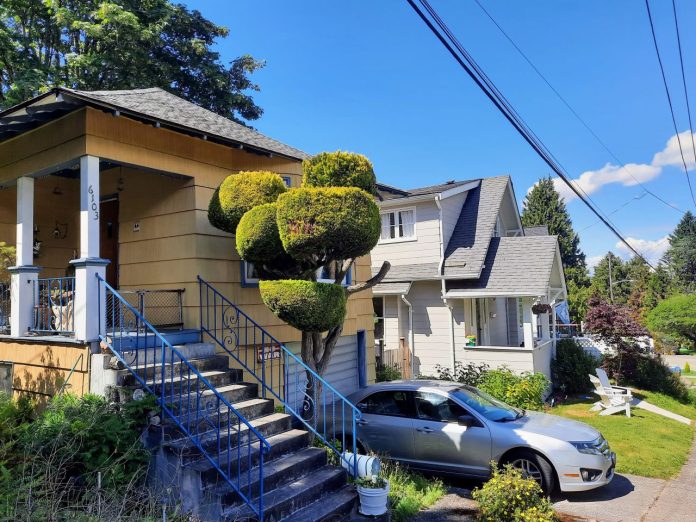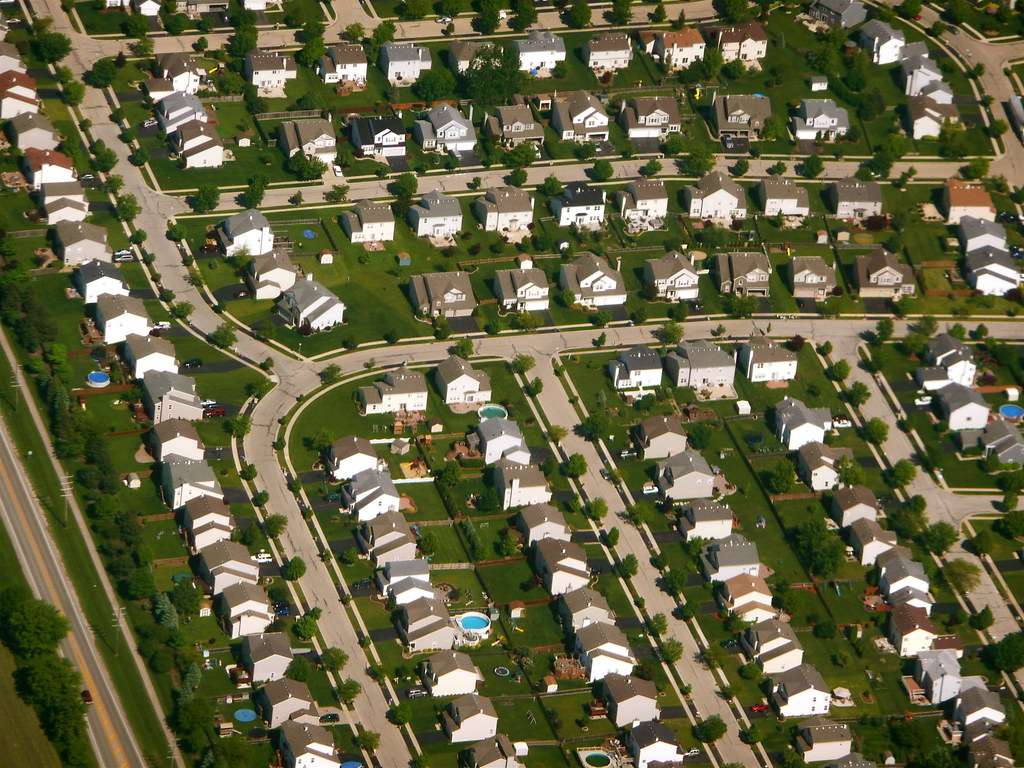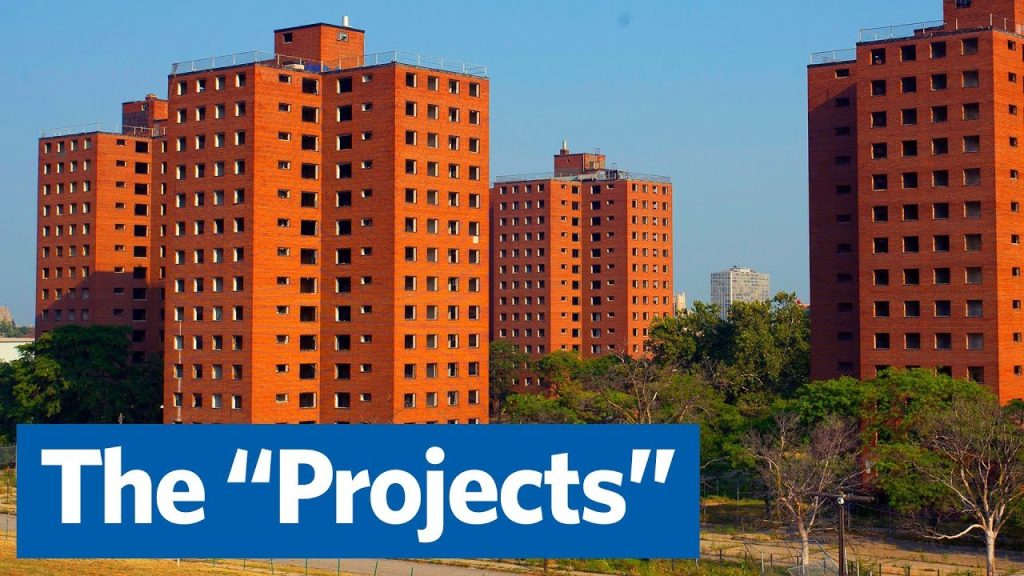
What is the American Dream without the single-family home, a two-car garage, and a white-picket fence?
When we are first introduced to Frank and April Wheeler in Sam Mendes’s 2008 Revolutionary Road they are living, by all outward appearances, a full version of the American Dream. The biggest marker of their social and financial success is their ideal suburban home, a two-story post-war home on Revolutionary Road.
It is on a large lot complete with a wide, green lawn and a two-car garage in suburban Connecticut.
Mendes’ film, like its source text Richard Yates’ 1961 novel, asks audiences to consider, among other things, the correlation between our domestic spaces and our sense of place in America, a relationship we have most often called “the American Dream.”

Today, the prospect of home ownership — whether in a suburb or in a city — eludes most people. For a long time, the cost of owning a home hovered around three times a buyer’s annual income; in 2023, the median home price was about five times a buyer’s annual income. The price of homes in the U.S. has increased by about 47% since the pandemic.
It is no wonder that housing and housing costs have risen to the national consciousness as much as it has. For the first part of 2024, housing was second only to inflation among the financial issues more Americans report caring about. For people aged 18-29, it ranks among the top three.
Housing attainability and affordability are therefore top-of-mind for voters (and non-voters) as we head into a national election. Both campaigns are making housing a central issue, even as both present different ideas about how the executive branch of the federal government can or might help address this complex issue.
In January, Congress’ Joint Economic Committee held a hearing titled “Rebuilding the American Dream: Policy Approaches to Increasing the Availability of Affordable Housing,” at which Brookings Institute senior fellow Jenny Schuetz laid out four steps the federal government could take to “support better functioning housing markets.” Those four steps are:
- Coordinate and disseminate research on effective policy solutions at the regional and local levels pertaining to the construction industry, zoning reforms, and affordable housing programs.
- Work with other federal agencies and the real estate industry to monitor housing market health.
- Encourage regional coordination among housing authorities.
- Build the Department of Housing and Urban Development’s capacity to monitor signs of “impending housing distress.”
What was made clear from this joint session is that the federal government — and the executive branch in particular — has few tools to actually effect change in the nation’s housing affordability and attainability crisis. At its core, our current housing affordability crisis is a matter of both too little housing stock in both the rental and for-sale markets and high direct buying costs and associated costs (i.e. insurance and transportation).
The government will not build more houses to help meet high demand, and its economic levers (i.e. incentives, credits, subsidies) have a limited impact on the overall shortage and can lead to price increases. Neither of the campaigns are talking about the government simply building more housing directly. One reason for this is likely the limitations the federal government imposed on itself through the 1998 Faircloth Amendment, which prohibits the expansion of public housing beyond 1999 levels.
If these two campaigns are, in part, distinguishable by the visions of “America” they put forward, these visions are tied to housing and place. Candidate Trump has disparaged cities and urban dwellers throughout his political careers, using terms like “failing” and threatening to use military troops to bring them under his control.
In 2020, Trump claimed that Joe Biden was seeking to abolish suburbs and he vowed to “protect them” by preserving local control over matters of zoning. Trump also wants to make federal land available for development, encouraging speculative sprawl into undeveloped rural areas. Trump’s plan builds on the existing “Opportunity Zone” investment scheme in which wealthy people can escape taxes for a period of time by investing in development in beleaguered areas as defined by the IRS.

The Harris campaign is making the “opportunity economy” central to her platform, a wide-reaching policy platform that seeks to lower overall costs for middle-class Americans, including the cost of housing. Harris calls for the expansion of the Low-Income Housing Tax Credit (LIHTC) and seeks to incentivize homebuilding through tax credits for developers who build rental housing targeted to lower-income households. Harris’ plan also wants to reduce red tape in permitting and review, and also would make federal land available for development. The Harris plan proposes three million new homes in the first four years of her administration.
Both campaigns propose indirect mechanisms to achieve the widely agreed upon solutions: build a lot more housing. Why is neither campaign proposing that the federal government do significant amounts of homebuilding nationwide? It has before. Through the New Deal, the Federal Housing Administration (FHA), and the Veterans Administration, the federal government built and/or financed new homes from the 1930s to the 1970s.
The New Deal delivered large housing projects in cities. Through FHA loans it subsidized the building of the American suburbs. “Projects,” as urban public housing was called, were much maligned and many communities were later demolished. Public housing critics argued those demolitions demonstrated the failures of “government housing” without consideration to the ways these had been set up to fail through a number of ways, including the federal government’s sponsorship of White Flight to the suburbs, which sapped support for funding the upkeep and expansion of public housing.

Despite the criticism and mainstream American public policy consensus against public housing expansion, millions of Americans were promised and provided with a version of the American Dream through these government programs that resulted in the building of millions of housing units.
If publicly funded and built housing was possible once, it is possible again. For 40 years the federal government ran two public housing programs. It could be said that the suburban housing program was possible only through the cannibalization of an urban housing program. Whereas the federal government effectively underwrote suburbanization, it failed to provide a way for urban housing programs to subsist once the tax base moved out to the suburbs. In time, homes fell to disrepair and those who stayed in cities were left to shoulder the blame for the failure of these programs.
(Whether or not suburban life can deliver the American Dream is something the Wheelers of Revolutionary Road, the Brannocks of Westfield, New Jersey in The Watcher, the Eberharts of the various instantiations of Stepford on Wilton, Connecticut, in the Stepford Wives can answer better than me.)
Zoning and the long tradition of local authority over land use is another reason the federal government — and certainly not the next president of the U.S. — can’t do much to solve our housing crisis.
This means that whether or not more housing is built becomes a matter of city councils, neighborhood councils, and homeowners associations, effectively. As Annie Lowrey writes in the Atlantic, “Residents of a given place have ample opportunities—zoning-board meetings, candidate forums, historical architectural reviews, city-council open mics—to stop development. So they do. And thus mostly wealthy, mostly older people shape policy to their preferences: keeping new families out, maintaining single-family zoning, stopping development, and prioritizing the aesthetic of buyers over the needs of renters.”
Home in Tacoma and zoning reforms like it are taking hold across the region and state, but “local control” remains a threat to these policy shifts. It is hard to see a way to create zoning reforms at the national level given the constitutional constraints at work, but perhaps this can be achieved through the recommendations made to the Joint Economic Committee earlier this year.
In the context of the real and created obstacles to the federal government actually doing something to address housing shortages and attainability, it is hard not see election talk about housing as nothing more than “campaign talk.” This is especially true when questions about specific plans to help the issue are taken as an opportunity to raise another issue, immigration, in unhelpful ways by one campaign.
But the federal government can do more to raise housing stocks and improve affordability. It can repeal the Faircloth Amendment, a self-imposed obstacle to building more public housing; it can expand housing credit programs (as the Harris-Walz campaign proposes to do); it can close the vast gaps impacting the housing vouchers programs so that more people can achieve housing that is safe and affordable.
At its core, actually addressing our national housing crisis will require a drastic shift in how we think about housing in our society: it needs to become a basic human right — something we are all entitled to and therefore something our government works to deliver — as opposed to a mechanism through which we build and transfer wealth.
Our place in U.S. society has been and will continue to center around the question of housing. We all carry opinions about status as it relates to where and how we live even as we know and understand how difficult it is to come by adequate and affordable housing.
The question of how we are going to address and fix our housing crisis is before us. It makes sense that the talk about housing and affordability has made it to the campaign platforms of both presidential candidates. But we ought to remember that questions of housing and affordability remain matters of regional and local concern. We have opportunities in our state and in our region to make housing more abundant and affordable even as we wait to see how the next president will or will not deliver on campaign promises.

Rubén Casas
Rubén joined The Urbanist's board in 2022. He is a scholar and teacher of rhetoric and writing at the University of Washington Tacoma. He is also the faculty lead of the Urban Environmental Justice Initiative at Urban@UW. In his work and advocacy, Rubén examines how cities and the institutions that comprise them imagine, plan, and build in ways that promote and/or discourage community and a sense of place.
